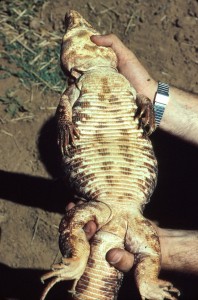Collaborators: Lucy Aquino, Margarita Mieres, Andrew Noss, Rosa Leny Cuellar, Rossy Montaño, Florencio Mendoza
A large part of my research on the conservation biology and ecology of Tupinambis lizards involves studying the ecological interactions between local people and the lizards they use for food and income.Tupinambis lizards are among the most extensively traded reptile species in the world. Importantly, thousands of rural and indigenous people depend on tegus for subsistence and income. My interdisciplinary approach stresses the importance of local people and has contributed enormously to the success of the research program as a conservation model. The major policy implementation of this research was creating a legally binding harvest monitoring programs permanently funded by a tax system in Argentina and Paraguay. In Paraguay, Tupinambis lizards are the only managed wildlife species in the country. We are implementing the Tupinambis research program in Bolivia. I am very pleased that my research has been applied in 3 countries. The Tupinambis research program, and how it relates to people in developing countries, is summarized in papers in Conservation Biology, American Zoologist, Interciencia (in Spanish), Journal of Wildlife Management, and a book chapter in Neotropical Wildlife Use and Conservation (University of Chicago Press). For full citations, visit my publications page.

